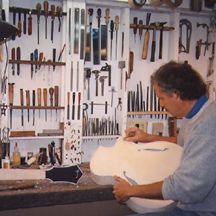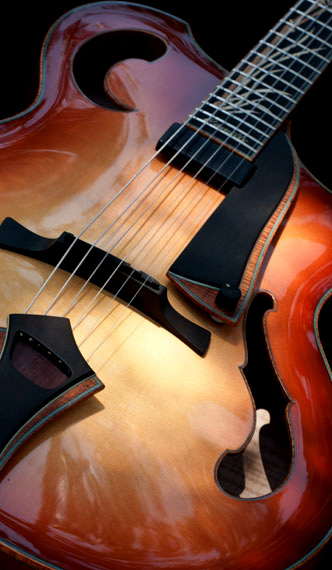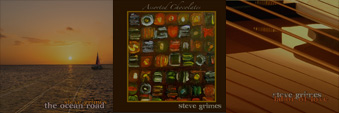DESIGN
Grimes instruments are an evolution of innovative design and traditional styling, utilizing the latest advances in acoustical technology, while retaining that “old world” quality and craftsmanship. During the design stage, the relationships between the size of the soundboard, the volume of enclosed air inside the body, and the arching of the top and back are all carefully considered to ensure the proper balance of the tone and the avoidance of “wolf tones” or distorting notes. The three and one half octave range of the guitar requires an optimum size ratio between these factors so that part of the range of the guitar is not lost due to an oversized or badly proportioned body.
MATERIALS
The first step in building an instrument is selecting woods that not only are beautiful, but which have great potential for response. For my arch top guitars I hand select the finest spruces and maples available. These woods, used for centuries in violin construction, have proven to be the most ideal for arch top instruments because of their superior tonal strength and striking beauty. Steel string and classic guitars are built with highly figured Hawaiian Koa, Brazilian, Madagascar and Indian Rosewoods, African Blackwood, Honduras Mahogany, Curly Walnut and Curly Maple. All woods are air dried and seasoned for years before being selected for a guitar. Fingerboards, bridges, tailpieces, fingerrests, and peghead overlays are of choice Gaboon ebony. Necks are of select, quarter sawn maple for the arch tops, and Honduras mahogany for the flat tops. Steel string guitar soundboards are Sitka spruce, with options for Englemann, Adirondack or German spruce. Classical guitar soundboards are Western Cedar, or Redwood with an option for German spruce. Each of these tonewoods has a distinctive timbre and is selected according to the player’s tonal requirements.
TONAL RESPONSE
The most important characteristic of an acoustic instrument is a full, well balanced tone. Special requirements for a particular tone desired by a customer are “built in” and the instrument’s response is customized to suit these needs. For further information on this subject, please request copies of transcriptions published in the American Luthiers Quarterly of presentations I’ve given to the Luthiers Convention on the subject of soundboard voicing.
Detail of Back of Coryell Guitar





